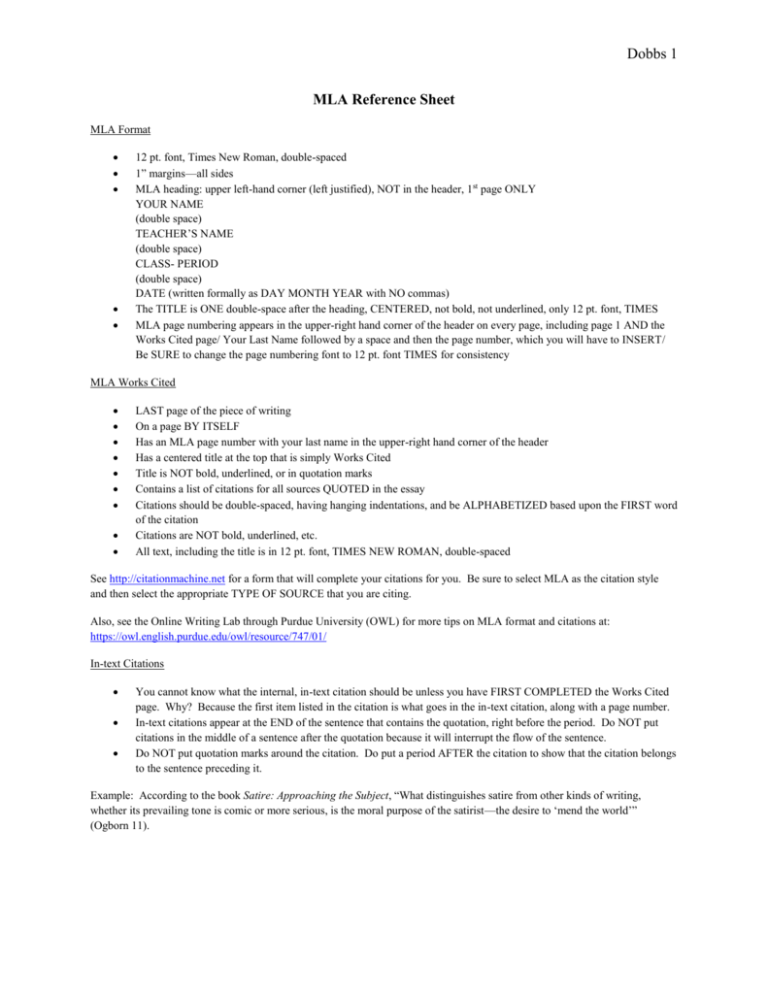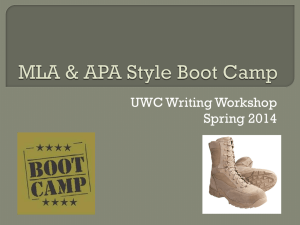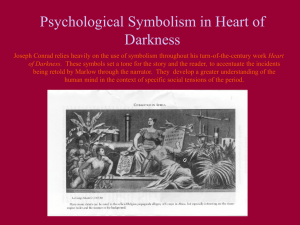MLA Reference Sheet
advertisement

Dobbs 1 MLA Reference Sheet MLA Format 12 pt. font, Times New Roman, double-spaced 1” margins—all sides MLA heading: upper left-hand corner (left justified), NOT in the header, 1st page ONLY YOUR NAME (double space) TEACHER’S NAME (double space) CLASS- PERIOD (double space) DATE (written formally as DAY MONTH YEAR with NO commas) The TITLE is ONE double-space after the heading, CENTERED, not bold, not underlined, only 12 pt. font, TIMES MLA page numbering appears in the upper-right hand corner of the header on every page, including page 1 AND the Works Cited page/ Your Last Name followed by a space and then the page number, which you will have to INSERT/ Be SURE to change the page numbering font to 12 pt. font TIMES for consistency MLA Works Cited LAST page of the piece of writing On a page BY ITSELF Has an MLA page number with your last name in the upper-right hand corner of the header Has a centered title at the top that is simply Works Cited Title is NOT bold, underlined, or in quotation marks Contains a list of citations for all sources QUOTED in the essay Citations should be double-spaced, having hanging indentations, and be ALPHABETIZED based upon the FIRST word of the citation Citations are NOT bold, underlined, etc. All text, including the title is in 12 pt. font, TIMES NEW ROMAN, double-spaced See http://citationmachine.net for a form that will complete your citations for you. Be sure to select MLA as the citation style and then select the appropriate TYPE OF SOURCE that you are citing. Also, see the Online Writing Lab through Purdue University (OWL) for more tips on MLA format and citations at: https://owl.english.purdue.edu/owl/resource/747/01/ In-text Citations You cannot know what the internal, in-text citation should be unless you have FIRST COMPLETED the Works Cited page. Why? Because the first item listed in the citation is what goes in the in-text citation, along with a page number. In-text citations appear at the END of the sentence that contains the quotation, right before the period. Do NOT put citations in the middle of a sentence after the quotation because it will interrupt the flow of the sentence. Do NOT put quotation marks around the citation. Do put a period AFTER the citation to show that the citation belongs to the sentence preceding it. Example: According to the book Satire: Approaching the Subject, “What distinguishes satire from other kinds of writing, whether its prevailing tone is comic or more serious, is the moral purpose of the satirist—the desire to ‘mend the world’” (Ogborn 11). Dobbs 2 Ms. Dobbs Dr. Foeller- Pituch LITL 410, section 50 13 November 2010 Moral Nihilism and the Façade of Civilization in Conrad’s Heart of Darkness Kurtz’s infamous words “‘The Horror! The Horror!’” from Joseph Conrad’s novel Heart of Darkness, reveal commentary about man’s inherent nature—that of amorality—as Kurtz confronts the “horror” of his actions upon his death (Conrad 98). Kurtz’s final confrontation with his innate nature reveals his acknowledgement of the necessity for civilization, defined as the act of “bring[ing] out of a state of barbarism, to instruct in the arts of life, and thus elevate in the scale of humanity” (“Civilize”). Despite the differences in civilizations among cultures throughout the world, all people need enforced control in order to prevent mankind from reverting to his natural state of amorality or moral nihilism, defined as “the doctrine that there are no reasons for morals because life has no purpose” (“Determinism”). Heart of Darkness explores this regression of mankind through Marlow’s journey of disillusionment as he embarks upon a mission into the heart of Africa for adventure but instead confronts the innate, moral nihilism of mankind when he meets the notorious Mr. Kurtz. At each stage of his journey up the African river, deeper into the wilderness and farther away from the controls of civilized society, Marlow gradually loses more and more of his optimism as he uncovers the reality of the colonist’ actions in Africa. In this respect, the river becomes the metaphorical representation of Marlow’s self-discovery and serves as the construct through which Marlow substantiates the façade of civilization. Dobbs 3 Works Cited "Civilize." The Concise Oxford Companion to American Literature. James D. Hart. Oxford University Press, 1986. Oxford Reference Online. Oxford University Press. Northwestern University. 7 November 2010 <http://www.oxfordreference.com.turing.library.northwestern.edu/views/ENTRY.h tml?subview=Main&entry=t53.e1652> Database. Conrad, Joseph. Heart of Darkness. New York, NY: Everyman’s Library, 1967. 9-34, 42-47, 98-99. Print. "Determinism, Doctrine/ Theory of." Elsevier&apos;s Dictionary of Psychological Theories. Oxford: Elsevier Science & Technology, 2006. Credo Reference. Web. 28 October 2010. “Socialization.” The Concise Oxford Companion to American Literature. James D. Hart. Oxford University Press, 1986. Oxford Reference Online. Oxford University Press. Northwestern University. 13 November 2010 <http://www.oxfordreference.com.turing.library.northwestern.edu/views/ENTRY. html?subview=Main&entry=t53.e1652> Database. Thomas, Brook. "Preserving and Keeping Order by Killing Time in Heart of Darkness." Case Studies in Contemporary Criticism: Joseph Conrad Heart of Darkness. 2nd ed. Ed. Ross C. Murfin. Boston, New York: Bedord/ St. Martin's, 1996. Print.








